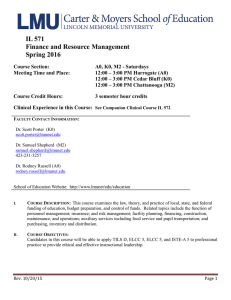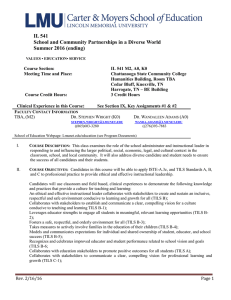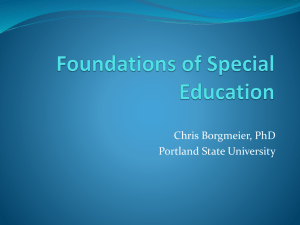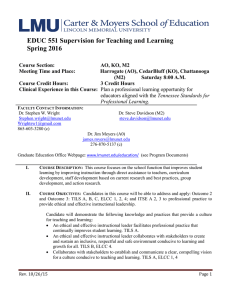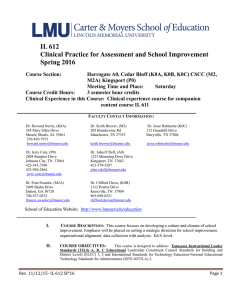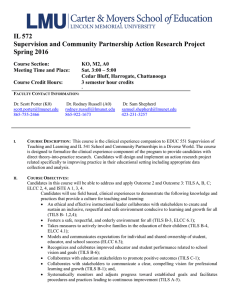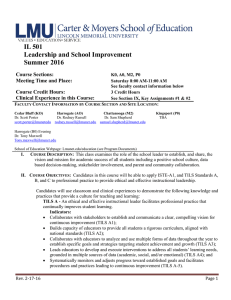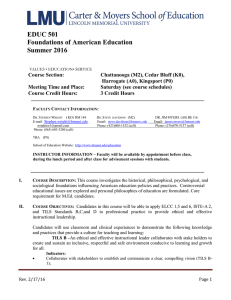Course Section: EDUC 511 K0-Research and Statistics Meeting Time and Place:
advertisement
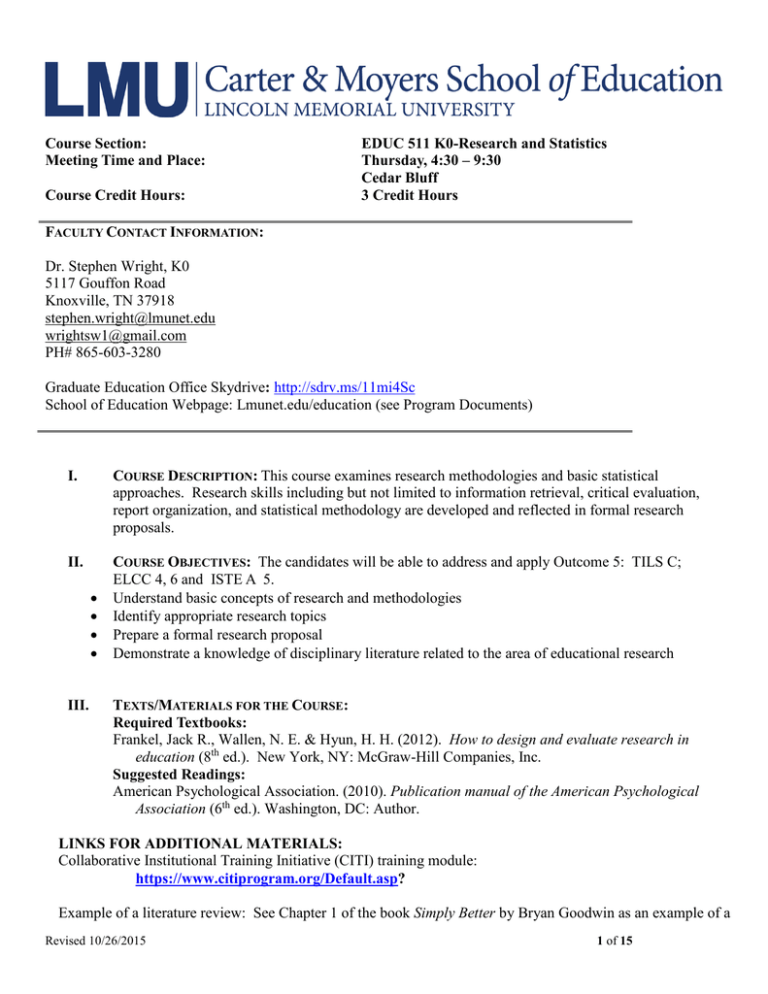
Course Section: Meeting Time and Place: Course Credit Hours: EDUC 511 K0-Research and Statistics Thursday, 4:30 – 9:30 Cedar Bluff 3 Credit Hours FACULTY CONTACT INFORMATION: Dr. Stephen Wright, K0 5117 Gouffon Road Knoxville, TN 37918 stephen.wright@lmunet.edu wrightsw1@gmail.com PH# 865-603-3280 Graduate Education Office Skydrive: http://sdrv.ms/11mi4Sc School of Education Webpage: Lmunet.edu/education (see Program Documents) I. COURSE DESCRIPTION: This course examines research methodologies and basic statistical approaches. Research skills including but not limited to information retrieval, critical evaluation, report organization, and statistical methodology are developed and reflected in formal research proposals. II. COURSE OBJECTIVES: The candidates will be able to address and apply Outcome 5: TILS C; ELCC 4, 6 and ISTE A 5. Understand basic concepts of research and methodologies Identify appropriate research topics Prepare a formal research proposal Demonstrate a knowledge of disciplinary literature related to the area of educational research • • • • III. TEXTS/MATERIALS FOR THE COURSE: Required Textbooks: Frankel, Jack R., Wallen, N. E. & Hyun, H. H. (2012). How to design and evaluate research in education (8th ed.). New York, NY: McGraw-Hill Companies, Inc. Suggested Readings: American Psychological Association. (2010). Publication manual of the American Psychological Association (6th ed.). Washington, DC: Author. LINKS FOR ADDITIONAL MATERIALS: Collaborative Institutional Training Initiative (CITI) training module: https://www.citiprogram.org/Default.asp? Example of a literature review: See Chapter 1 of the book Simply Better by Bryan Goodwin as an example of a Revised 10/26/2015 1 of 15 review of literature: http://www.ascd.org/publications/books/111038/chapters/Guaranteeing-Challenging,Engaging,-and-Intentional-Instruction.aspx IV. COURSE REQUIREMENTS, ASSESSMENT (LEARNING OUTCOMES) AND EVALUATION METHODS: Requirements (see Course Outline and Requirements section) 1. Reading and discussion of required materials. See related discussion guides 2. In-class writings 3. Any other readings or in-class activities that the instructor may assign 4. Group Projects: Groups will research assigned topics for presentation to the class. 5. Key Assignments: Each course includes two Key Assignments that are critical to successful completion of the course. Key Assignments are submitted via Live Text and will be assessed electronically by the instructor using a rubric. In addition to the Key Assignments, the instructor may require other coursework. Evaluation Method: Assignments will be evaluated based on program standards using various assessment tools, including LiveText adopted rubrics. The University official Graduate Education grading system will be utilized. Attendance Policy: Cooperative and group learning strategies are the essence of the graduate program. When class absences occur, students can make up for knowledge and skills missed from the instructor, but they are not able to make up for the knowledge and skills their participation in class would have provided to their own learning and to their fellow students’ learning. Therefore, attendance at all class meetings is crucial to success. Candidates are allowed one absence per course without grade reduction. Other absences are addressed as follows: 2 absences results in: minus (-), 3 absences results in reduction of letter grade. More than three absences result in the candidate being required to retake the course. Students may not make up for an absence at another class site. Refer to the Graduate Catalog for further academic restrictions. If a class is cancelled by LMU due to weather or other unforeseen circumstances, a make-up date may be scheduled. V. METHODS OF INSTRUCTION: Instructional methods will include lecture, class discussion, reflection, collaborative assignments, group presentations, problem solving, and written assignments. CLINICAL EXPERIENCES: In courses with Clinical Experiences, candidates will receive regular coaching and feedback from mentors. The coaching process must be documented, for example, through an Activity/Time Log or Formal Evaluations. VI. INFORMATION LITERACY/TECHNOLOGICAL RESOURCES: Technology: Incoming students must be computer literate, able to use software for e-mail, word processing, web browsing, and information retrieval. Students must have access to the Internet for communicating with instructors and accessing learning resources. Computer access must be available on a personal computer. Turn-it-in: Turn-It-In, the computer program designed for checking literature duplication is available Revised 10/26/2015 2 of 15 for use. Submitting course work to Turn-It-In is at the instructor’s discretion. Instructions will be available early in the semester on the Graduate Education Office webpage. Live Text: Each student will be required to establish or continue an account with the Live Text program. Live Text is a web-based application offering a comprehensive suite of development, management, and assessment tools. This suite of tools provides colleges and universities with the capability to assess student work using assessment instruments that have been developed and implemented by the individual college faculty and/or departments. LiveText may be purchased online at http://livetext.com or through the LMU Bookstore. LiveText HELP is available at the Carter and Moyers Education website (www.lmunet.edu/education) Library Resources (Revised 2/2/2012) The Carnegie-Vincent Library provides access to many outstanding resources for students in Teacher Education field, including tutorials, databases, and experienced reference librarians. Visit the library’s website (library.lmunet.edu) for full details. There are many professional databases including: ERIC, the Educational Resource Information Center, the premier database for education related journal articles and documents containing over one million citations and links to more than 100,000 documents in fulltext; ProQuest Education Journals database which contains access to 760 leading journals of which over 600 are in full-text; ProQuest Dissertation & Theses Full Text: The Humanities and Social Sciences Collection: A comprehensive collection of scholarly research in the Humanities and Social Sciences, this database covers more than one million dissertations and theses; Mental Measurements Yearbook which contains descriptive information and critical reviews of commercially-available standardized English-language educational, personality, aptitude, neuropsychological, achievement and intelligence tests. Additionally, the library provides access to over 100 other databases and can obtain books and articles from libraries worldwide through Interlibrary Loan. VII. UNIVERSITY POLICIES STUDENTS WITH DISABILITIES POLICY: As a rule, all students must read and comply with standards of the LMU Student Handbook and LMU catalogue. Any student seeking assistance in accordance with the Americans Disabilities Act (1990 as amended) should contact the Director of Counseling and ADA, Jason Kishpaugh, with regard to required documentation and in order to make appropriate arrangements. Contact information: jason.kishpaugh@lmunet.edu and/or 423.869.6401 (800-325-0900 ext. 6401). The office is located on the second floor of Duke, office 201. UNIT COMMITMENT TO DIVERSITY – The School of Education recognizes differences among groups of people and individuals based on ethnicity, race, socioeconomic status, gender, exceptionalities, language, religion, sexual orientation, and geographical area. The unit designs, implements, and evaluates curriculum and provides experiences for candidates to acquire and demonstrate the knowledge, skills, and professional dispositions necessary to help all students learn. Assessments indicate that candidates can demonstrate and apply proficiencies related to diversity. Experiences provided for candidates include working with diverse populations, including higher education and K-12 school faculty, candidates, and students in K-12 schools. COUNSELING: LMU counselors are available to help current students with personal, career, and academic concerns that affect academic success and quality of life. The Director of Counseling, Jason Kishpaugh, can be contacted at jason.kishpaugh@lmunet.edu and/or 423.869.6401 (800-325-0900 ext. 6401). DISCRIMINATION, SCHOLASTIC DISHONESTY, CHEATING, AND PLAGIARISM POLICIES can be found in the student handbook or at the Revised 10/26/2015 3 of 15 LMU’s website: http://www.lmunet.edu/campuslife/handbooks.shtml. COURSE EVALUATIONS: In addition to meeting degree requirements specified in the graduate and undergraduate catalogs, all students are required to complete University-administered course evaluations. OUTCOMES ASSESSMENT TESTING: Degree requirements include participating in all outcomes assessment testing (e.g., general education assessment, major field tests, etc.) and activities when requested. Students may be required to complete one or more questionnaires and to take one or more standardized tests to determine general educational achievement as a prerequisite to graduation (see appropriate catalog for additional information). All Associate of Science – Nursing; Associate of Science – Veterinary Health Science; and Associate of Science – Veterinary Medical Technology students must take the General Education Proficiency Profile examination. LMU’S INCLEMENT WEATHER POLICY can be found at the following link to LMU’s website: http://www.lmunet.edu/curstudents/weather.shtml. Students should check their LMU email during delays/closures to receive information from individual faculty regarding potential assignments and/or other course information. PROFESSIONAL CERTIFICATION AND LICENSURE DISCLAIMER – Authorization for the University to provide a program for the preparation of teachers, counselors, or administrators, does not guarantee eligibility for certification, licensure, or benefits. It is the sole responsibility of the candidate to be knowledgeable about specific state certification/licensure/benefits requirements, qualify for certification, licensure, or benefits and apply for the same. SYLLABI: The syllabus for each MEd class is cooperatively developed by faculty who are currently teaching the course. These syllabi are found under the “Degrees and Programs” tab on the LMU School of Education website found at www.lmunet.edu/education/. Look under specific course numbers for Spring 2016 MEd. Syllabi and Class Materials. IT IS THE RESPONSIBILITY OF EACH STUDENT TO PRINT SYLLABI, FROM THE WEB PAGE, FOR EACH SEMESTER AND BRING THEM TO THE FIRST CLASS MEETING. FOR ALABAMA STUDENTS: Alabama Commission on Higher Education Disclaimer Statement State authorization to provide a program related to the preparation of teachers or other P-12 school/system personnel does not indicate eligibility for an Alabama certificate. Applicants for an Alabama certificate based on reciprocity must meet Alabama’s test requirements and submit a valid, renewable professional educator certificate/license issued by another state at the degree level, grade level, and in the teaching field or area of instructional support for which an Alabama certificate is sought and for which Alabama issues a certificate. Applicants for Alabama certification in an area of administration must also document at least three years of full-time employment as an administrator in a P-12 school system(s). www.alsde.edu Revised 10/26/2015 4 of 15 VIII. MISSION STATEMENTS: LINCOLN MEMORIAL UNIVERSITY MISSION STATEMENT can be found at the following: http://www.lmunet.edu/about/mission. CARTER & MOYERS SCHOOL OF EDUCATION MISSION STATEMENT: HTTP://WWW.LMUNET.EDU/EDUCATION CARTER & MOYERS GRADUATE SCHOOL OF EDUCATION MISSION STATEMENT: HTTP://WWW.LMUNET.EDU/EDUCATION INSTRUCTIONAL LEADERSHIP MISSION STATEMENT: HTTP://WWW.LMUNET.EDU/EDUCATION MED CG (SCHOOL AND MENTAL HEALTH COUNSELING) MISSION STATEMENT: HTTP://WWW.LMUNET.EDU/EDUCATION) CURRICULUM AND INSTRUCTION MISSION STATEMENT: HTTP://WWW.LMUNET.EDU/EDUCATION EDUCATIONAL LEADERSHIP MISSION STATEMENT: HTTP://WWW.LMUNET.EDUCATION IX. COURSE OUTLINE/ASSIGNMENT/: Candidate Outcome 5: Educational Advocacy Candidates who complete the program are ethical leaders who apply knowledge that promotes the success of every student by understanding, responding to, and influencing the larger political, social, economic, legal, and cultural context through advocating for school students, families, and caregivers; acting to influence local, district, state, and national decisions affecting student learning in a school environment; and anticipating and assessing emerging trends and initiatives in order to adapt schoolbased leadership strategies. • TILS D: Resource Management ELCC 4: Candidates who complete the program are educational leaders who have the knowledge and ability to promote the success of all students by collaborating with families and other community members, responding to diverse community interest and needs, and mobilizing community resources. ELCC 6 Candidates who complete the program are educational leaders who have the knowledge and ability to promote the success of all students by understanding, responding to, and influencing the larger political, social, economic, legal, and cultural context. ISTE A 5 Digital Citizenship KEY ASSIGNMENTS: KA #1 Clinical Practice Assignment: Evaluation of Research-based Instructional Materials: Locate an educational resource or instructional material (such as a text book or reading program) in a local school that claims to be “research-based.” Examine the research cited by the publisher. Critique the study according to the following elements: • Sample size • Effect size • Research base • Limitations of study • Parameters or special conditions Revised 10/26/2015 5 of 15 Is the research sufficient to back up the claims of the program? Is this a resource that would be appropriate for use with students? Assessment: LiveText: Evaluation of Research-Based Instructional Materials Rubric KA #2: Research Proposal: Each candidate will develop a research proposal. Proposals will include: • Title Page • Abstract • Table of Contents • Statement of problem • Purpose of the study • Justification of the study • Research questions • Review of literature • Definitions of terms • Methodology • References • Appendix • APA format Assessment: LiveText Rubric Connecting Theory, Research, and Practice ADDITIONAL STUDENT ASSIGNMENTS FOR EDUC 511 1. Prepare a notebook with hard copies of all work as requested. 2. Five questions/topics 3. Draft of Research Proposal first seven items 4. Three to Five Literature Reviews 5. Chapter Presentations 6. Research Proposal 7. Other assignments to be determined. Professor will provide a course outline during the first class session. X. Each Instructor may insert miscellaneous course elements here, as desired – numbered in sequence: [Optional Sections.] XI. Student Community Engagement: A cornerstone of the University’s mission is service to humanity. As part of the University’s Student Service Initiative, students receiving any form of institutional aid participate in at least 10 hours of service learning per semester. Students are encouraged to network with one another in classroom settings and with instructors and advisors for searching out and creating appropriate service learning projects related to their field of study. For more information visit: http://www.lmunet.edu/campuslife/initiative/index.shtml or contact the Associate Dean of Students. PLAGIARISM Plagiarism is the presentation of someone else’s words or ideas as one’s own (See APA Publication Manual, 6th ed., pp.15-16). One of the most common forms of plagiarism is the paraphrasing of several phrases, sentences of ideas in a paragraph with only one citation at the end of the paragraph, resulting in confusion between the cited content and the researcher’s own words or ideas. Another common form is the practice of Revised 10/26/2015 6 of 15 substituting words or phrases while retaining the original author’s for and structure. Plagiarism in any form is one of the most egregious violations of professional ethics an author can commit. Submission of plagiarized material, even by accident or ignorance, is a severe infraction of the professional ethical code and can result in expulsion from the program. To avoid plagiarism: Cite sources within the text for all phrases or ideas that are quoted or paraphrased. Cite sources within the text in the format delineated in the APA Manual, pp. 174-179. CERTIFICATION OF AUTHORSHIP. I certify that I am the author of this paper titled ________________ and that any assistance I received in its preparation is fully acknowledged and disclosed in the paper. I have also cited any sources from which I used data, ideas, or words, either quoted directly or paraphrased. I also certify that this paper was prepared by me specifically for this course. I understand that falsification of information will affect my status as a graduate student. Student’s Signature___________________________________________________ ______________ Date (This statement must be included with all written assignments.) XII. THE INSTRUCTOR RESERVES THE RIGHT TO REVISE, ALTER AND/OR AMEND THIS SYLLABUS, AS NECESSARY. STUDENTS WILL BE NOTIFIED IN WRITING AND/OR BY EMAIL OF ANY SUCH REVISIONS, ALTERATIONS AND/OR AMENDMENTS. Revised 10/26/2015 7 of 15 TENNESSEE INSTRUCTIONAL LEADERSHIP STANDARDS (TILS) Standard A: Instructional Leadership for Continuous Improvement An ethical and effective instructional leader facilitates professional practice that continually improves student learning. Indicators: 1. Collaborates with stakeholders to establish and communicate a clear, compelling vision for continuous improvement. 2. Builds capacity of educators to provide all students a rigorous curriculum, aligned with national standards. 3. Collaborates with educators to analyze and use multiple forms of data throughout the year to establish specific goals and strategies targeting student achievement and growth. 4. Leads educators to develop and execute interventions to address all students’ learning needs, grounded in multiple sources of data (academic, social, and/or emotional). 5. Systematically monitors and adjusts progress toward established goals and facilitates procedures and practices leading to continuous improvement. Standard B: Culture for Teaching and Learning An ethical and effective instructional leader collaborates with stakeholders to create and sustain an inclusive, respectful and safe environment conducive to learning and growth for all. Indicators: 1. Collaborates with stakeholders to establish and communicate a clear, compelling vision for a culture conducive to teaching and learning 2. Leverages educator strengths to engage all students in meaningful, relevant learning opportunities. 3. Fosters a safe, respectful, and orderly environment for all. 4. Takes measures to actively involve families in the education of their children. 5. Models and communicates expectations for individual and shared ownership of student, educator, and school success. 6. Recognizes and celebrates improved educator and student performance related to school vision and goals. Standard C: Professional Learning and Growth An ethical and effective instructional leader develops capacity of all educators by designing, facilitating, and participating in collaborative learning informed by multiple sources of data. Indicators: 1. Collaborates with stakeholders to communicate a clear, compelling vision for professional learning and growth. 2. Implements and monitors a rigorous evaluation system using an approved Tennessee evaluation model. 3. Uses educator evaluation data to inform, assess, and adjust professional learning goals and plans. 4. Engages faculty and self in data-informed, differentiated professional learning opportunities for educators, aligned with the Tennessee Standards for Professional Learning. 5. Collaborates with others to induct, support, retain and/or promote effective educators based on evidence of student and educator outcomes 6. Identifies and supports potential teacher-leaders and provides growth opportunities in alignment with the Tennessee Teacher Leadership Standards. 7. Improves self-practice based on multiple sources of feedback, including performance evaluation results and self-reflection. Standard D: Resource Management An ethical and effective instructional leader facilitates the development of a highly effective learning community through processes that enlist diverse stakeholders and resources. Indicators: 1. Strategically utilizes community resources and partners to support the school’s mission, vision, and goals. 2. Includes a diverse set of educators and stakeholders in school improvement decisions. 3. Establishes, communicates, and enforces a set of standard operating procedures and routines aligned with district, state, and federal policy. 4. Performs all budgetary and responsibilities with accuracy, transparency, and in the best interest of students and staff. Revised 10/26/2015 8 of 15 International Society for Technology Education (ISTE A) Standards for Administrators 1. Visionary Leadership - Educational Administrators inspire and lead development and implementation of a shared vision for comprehensive integration of technology to promote excellence and support transformation throughout the organization. a. Inspire and facilitate among all stakeholders a shared vision of purposeful change that maximizes use of digital-age resources to meet and exceed learning goals, support effective instructional practice, and maximize performance of district and school leaders b. Engage in an ongoing process to develop, implement, and communicate technology-infused strategic plans aligned with a shared vision c. Advocate on local, state and national levels for policies, programs, and funding to support implementation of a technologyinfused vision and strategic plan 2. Digital Age Learning Culture - Educational Administrators create, promote, and sustain a dynamic, digital-age learning culture that provides a rigorous, relevant, and engaging education for all students. a. Ensure instructional innovation focused on continuous improvement of digital-age learning b. Model and promote the frequent and effective use of technology for learning c. Provide learner-centered environments equipped with technology and learning resources to meet the individual, diverse needs of all learners d. Ensure effective practice in the study of technology and its infusion across the curriculum e. Promote and participate in local, national, and global learning communities that stimulate innovation, creativity, and digital age collaboration 3. Excellence in Professional Practice - Educational Administrators promote an environment of professional learning and innovation that empowers educators to enhance student learning through the infusion of contemporary technologies and digital resources. a. Allocate time, resources, and access to ensure ongoing professional growth in technology fluency and integration b. Facilitate and participate in learning communities that stimulate, nurture and support administrators, faculty, and staff in the study and use of technology c. Promote and model effective communication and collaboration among stakeholders using digital age tools d. Stay abreast of educational research and emerging trends regarding effective use of technology and encourage evaluation of new technologies for their potential to improve student learning 4. Systemic Improvement - Educational Administrators provide digital age leadership and management to continuously improve the organization through the effective use of information and technology resources. a. Lead purposeful change to maximize the achievement of learning goals through the appropriate use of technology and mediarich resources b. Collaborate to establish metrics, collect and analyze data, interpret results, and share findings to improve staff performance and student learning c. Recruit and retain highly competent personnel who use technology creatively and proficiently to advance academic and operational goals d. Establish and leverage strategic partnerships to support systemic improvement e. Establish and maintain a robust infrastructure for technology including integrated, interoperable technology systems to support management, operations, teaching, and learning 5. Digital Citizenship - Educational Administrators model and facilitate understanding of social, ethical and legal issues and responsibilities related to an evolving digital culture. a. Ensure equitable access to appropriate digital tools and resources to meet the needs of all learners b. Promote, model and establish policies for safe, legal, and ethical use of digital information and technology c. Promote and model responsible social interactions related to the use of technology and information d. Model and facilitate the development of a shared cultural understanding and involvement in global issues through the use of contemporary communication and collaboration tools Revised 10/26/2015 9 of 15 ELCC Standards 1.0 Candidates who complete the program are educational leaders who have the knowledge and ability to provide the success of all students by facilitating the development, articulation, implementation, and stewardship of a school or district vision of learning. 1.1 Develop a Vision 1.2 Articulate a Vision 1.3 Implement a Vision 1.4 Steward a Vision 1.5 Promote Community Involvement in the Vision. 2.0 Candidates who complete the program are educational leaders who have the knowledge and ability to promote the success of all students by promoting a positive school culture, providing an effective instructional program, applying best practice to student learning, and designing comprehensive professional growth plans for staff 2.1 Promote Positive School Culture 2.2 Provide Effective Instructional Program 2.3 Apply Best Practice to Student Learning 2.4 Design Comprehensive Professional 3.0 Candidates who complete the program are educational leaders who have the knowledge and ability to promote the success of all students by managing the organization, operations, and resources in a way that promotes a safe, efficient, and effective learning environment. 3.1 Manage the organization 3.2 Manage Operations 3.3 Manage Resources 4.0 Candidates who complete the program are educational leaders who have the knowledge and ability to promote the success of all students by collaborating with families and other community members, responding to diverse community interest and needs, and mobilizing community resources. 4.1 Collaborates With Community and Other Family Members 4.2 Respond to Community Interests and Needs 4.3 Mobilize Community Resources 5.0 Candidates who complete the program are educational leaders who have the knowledge and ability to promote the success of all students by acting fairly, with integrity, and in an ethical manner. 5.1 Acts with Integrity 5.2 Acts Fairly 5.3 Acts Ethically 6.0 Candidates who complete the program are educational leaders who have the knowledge and ability to promote the success of all students by understanding, responding to, and influencing the larger political, social, economic, legal, and cultural context. 6.1 Understand the Larger Context 6.2 Respond to the Larger Context 6.3 Influence the Larger Context 7.0 Internship. The internship provides significant opportunities for candidates to synthesize and apply the knowledge and practice and develop the skills identified in Standards 1-6 through substantial, sustained, standards-based work in real settings, planned and guided cooperatively by the institution and school district personnel for graduate credit. 7.1 Substantial 7.2 Sustained Revised 10/26/2015 10 of 15 EDUC 511 KA#1 Evaluation of Research-Based Instructional Materials Rubric 4 Capstone 3 Milestones 2 Milestones 1 Benchmark NA (4.000 pts) (3.000 pts.) (2.000 pts) (1.000 pt.) (0.000 pt.) Candidate NA Candidate did Selection of NA selected not an appropriate select an Materials Commercially appropriate (1.000, 8%) produced commercially instructional produced material which instructional claims to be material which “researchclaims to be “researchThoroughly Analyzed the Limited number Analysis of Thoroughly analyzed the effect size or of elements Effect Size analyzed the (2.000, effect size or effect size or other statistical present and 16%) other statistical other statistical analysis provided needing analysis provided analysis provided by publisher. improvement. TILS C by publisher. by publisher. ELCC 6 Provided Provided some thoughtful insights related to insights related to effect size. effect size. Addressed some Addressed few Limited Analysis of Addressed key questions about key questions questions about elements Research the study such as about the study the study such as present and Base (2.000.16%) funding source, such as funding funding source, needing TILS C appropriateness source, appropriateness improvement. of design, appropriateness of design, Important ideas ELCC 6 thoroughness of of design, thoroughness of are missing. ISTE A 5 analysis, and thoroughness of analysis, trustworthiness analysis, and trustworthiness of study. trustworthiness of of study. study. Discussed and Discussed Limited Analysis of Discussed and analyzed limitations of the elements Limitations thoroughly analyzed limitations of the study. Made present and of Study (2.000, limitations of the study. Make some judgments needing 16%) TILS study. Made adjustments regarding improvement. C informed regarding limitations of ELCC 6 judgments limitations of study. regarding study. limitations of study. Parameters or Special Conditions of Study (2.000, 16%) TILS Discussed and thoroughly analyzed the parameters or any special conditions of the Revised 10/26/2015 Discussed and analyzed the parameters or any special conditions of the study if appropriate. Discussed and analyzed some of the parameters or any special conditions of the study if Limited elements present. 11 of 15 C ELCC 4 Final Analysis of Materials (2.000, 16%) TILS C ELCC 4 ISTE A 5 study if appropriate. Provides a thorough and thoughtful analysis of the study including recommendations to consumers regarding whether or not they should purchase this material based on the research. Revised 10/26/2015 appropriate. Provides an analysis of the study including recommendations to consumers regarding whether or not they should purchase this material based on the research. Provides little analysis of the study includes few recommendations to consumers regarding whether or not they should purchase this material based on the research. Limited elements present. Weak or no final analysis present. 12 of 15 EDUC 511 KA #2 Research Proposal Rubric Capstone Milestone 3 (4.000 pts) (3.000 pts) Defines the Determine the Effectively defines the scope of a Extent of scope of a research Information research question or Neededthesis (13.000, 13%) question or TILS C thesis. completely. ELCC 6 Effectively Can determines key determine key concepts. concepts. Sources Sources selected selected relate directly relate to concepts or to concepts or answer answer research research question/s. question/s. Access the Needed information(12,000, 12%) TILS C ISTE A 5 ELCC 6 Existing Knowledge, research, and/or views TILS C ELCC 4 ISTE A5 Revised 10/26/2015 Assesses information using effective, well-designed search strategies and most appropriate information sources. Synthesizes indepth information from relevant sources representing various points of view/ approaches Accesses information using variety of search strategies and some relevant information sources. Demonstrates ability to refine search. Presents indepth information from relevant sources representing various points of view/ approaches. Milestone 2 (2.000 pts) Defines the scope of a research question or thesis incompletely (parts are missing, remains too broad or too narrow, etc.) Can determine key concepts. Sources selected partially relate to concepts or answer research questions/s. Accesses information using simple search strategies, retrieves information from limited and similar sources. Benchmark NA (1.000 pt.) (0 pt.) Has difficulty defining the scope of a research question or thesis. Has difficulty determining key concepts. Sources selected do not relate to concepts or answer research question/s. Presents information from relevant sources representing limited points of view/ approaches. Presents information from irrelevant sources representing limited points of view/approaches. Accesses information randomly, retrieves information that lacks relevance and quality. 13 of 15 Evaluate Information and its Sources Critically(12.000, 12%) TILS C ELCC 5 Use Information Effectively to Accomplish a Specific Purpose(13.000, 13%) TILS C ELCC 6 ISTE a 5 Access and Use Information Ethically and Legally(13.000 13%) TILS C ISTE A 5 Revised 10/26/2015 Systematically analyzes own and others’ assumptions and carefully evaluates the relevance of contexts when presenting a position. Identifies own and others’ assumptions and several relevant contexts when presenting a position. 4 Capstone (4.000 pts) Communicate, organizes and synthesizes information from sources to fully achieve a specific purpose, with clarity and depth. 3 Milestones (3.000 pts) Communicates, organizes and synthesizes information from sources. Intended purpose is achieved. TILS C ELCC 6 ISTE A 5 Correctly uses all of the following information strategies: 1. Use of citations and references; 2. Choice of paraphrasing, summary, or quoting; 3.Using information in ways that are Correctly uses three of the following information strategies 1. Use of citations and references; 2. Choice of paraphrasing, summary, or quoting; 3. Using information in ways that are Questions some assumptions. Identifies several relevant contexts when presenting a position. May be more aware of others’ assumptions than one’s own (or vice versa). 2 Milestones (2.000 pts) Communicate s and organizes information from sources. The information is not yet synthesized, so the intended purpose is not fully achieved. Shows an emerging awareness of present assumptions (sometimes labels assertions as assumptions). Begins to identify some contexts when presenting a position. Correctly uses two of the following information use strategies 1. Use of citations and references; 2. Choice of paraphrasing, summary, or quoting; 3. using information in ways that are Correctly uses one of the following information use strategies 1.Use of citations and references; 2.choice of paraphrasing summary, or quoting; 3.Using information in ways that are true to original context; 1 Benchmark No Evidence (1.000 pt.) (0.000 pt.) Communicates information from sources. The information is fragmented and/or used inappropriately (misquoted, taken out of context, or incorrectly paraphrased, etc.) so the intended purpose is not achieved. 14 of 15 true to original context: 4. Distinguishing between common knowledge and ideas requiring attribution. Demonstrates a full understanding of the ethical and legal restrictions on the use of published, confidential, and/or proprietary information. Revised 10/26/2015 true to original context; 4. Distinguishing between common knowledge and ideas requiring attribution. Demonstrates a full understanding of the ethical and legal restrictions on the use of published, confidential, and/or proprietary information. true to original context; 4. Distinguishing between common knowledge and ideas requiring attribution. Demonstrates a full understanding of the ethical and legal restrictions on the use of published, confidential, and/or proprietary information. 4.Distinguishing between common knowledge and ideas requiring attribution: Demonstrates a full understanding of the ethical and legal restrictions on the use of published, confidential, and/or proprietary information. 15 of 15

